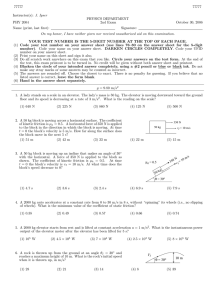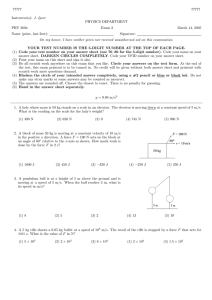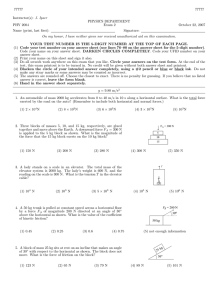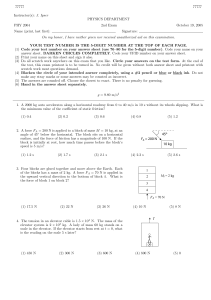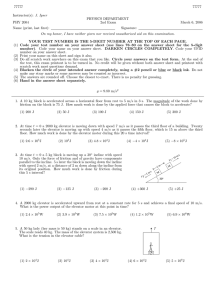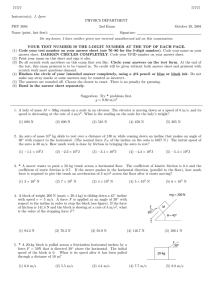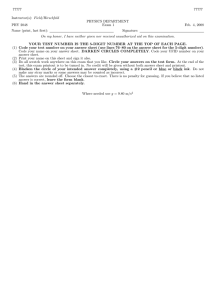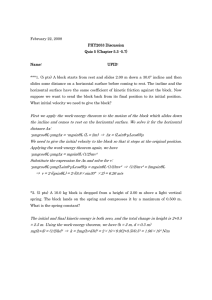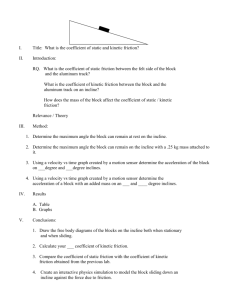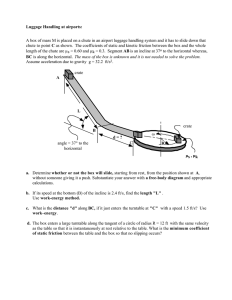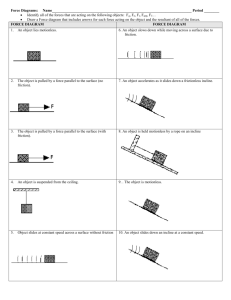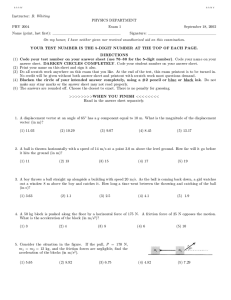77777 J. Ipser PHYSICS DEPARTMENT PHY 2004
advertisement
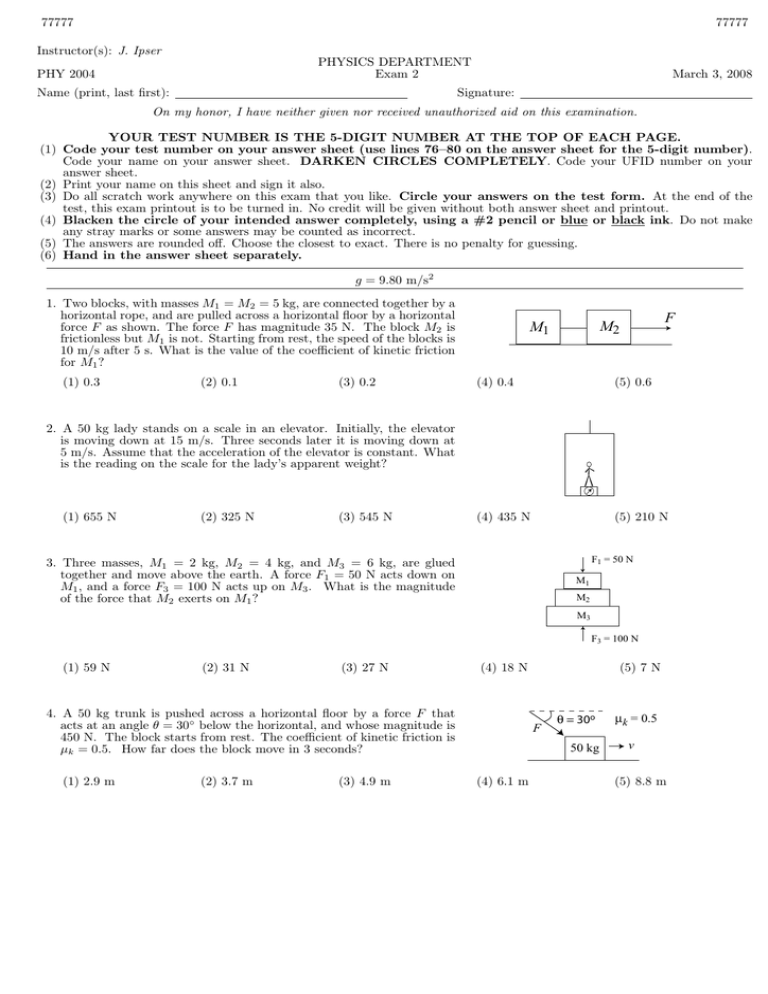
77777 77777 Instructor(s): J. Ipser PHYSICS DEPARTMENT Exam 2 PHY 2004 Name (print, last first): March 3, 2008 Signature: On my honor, I have neither given nor received unauthorized aid on this examination. YOUR TEST NUMBER IS THE 5-DIGIT NUMBER AT THE TOP OF EACH PAGE. (1) Code your test number on your answer sheet (use lines 76–80 on the answer sheet for the 5-digit number). Code your name on your answer sheet. DARKEN CIRCLES COMPLETELY. Code your UFID number on your answer sheet. (2) Print your name on this sheet and sign it also. (3) Do all scratch work anywhere on this exam that you like. Circle your answers on the test form. At the end of the test, this exam printout is to be turned in. No credit will be given without both answer sheet and printout. (4) Blacken the circle of your intended answer completely, using a #2 pencil or blue or black ink. Do not make any stray marks or some answers may be counted as incorrect. (5) The answers are rounded off. Choose the closest to exact. There is no penalty for guessing. (6) Hand in the answer sheet separately. g = 9.80 m/s2 1. Two blocks, with masses M1 = M2 = 5 kg, are connected together by a horizontal rope, and are pulled across a horizontal floor by a horizontal force F as shown. The force F has magnitude 35 N. The block M2 is frictionless but M1 is not. Starting from rest, the speed of the blocks is 10 m/s after 5 s. What is the value of the coefficient of kinetic friction for M1 ? (1) 0.3 (2) 0.1 (3) 0.2 F M2 M1 (4) 0.4 (5) 0.6 (4) 435 N (5) 210 N 2. A 50 kg lady stands on a scale in an elevator. Initially, the elevator is moving down at 15 m/s. Three seconds later it is moving down at 5 m/s. Assume that the acceleration of the elevator is constant. What is the reading on the scale for the lady’s apparent weight? (1) 655 N (2) 325 N (3) 545 N F1 = 50 N 3. Three masses, M1 = 2 kg, M2 = 4 kg, and M3 = 6 kg, are glued together and move above the earth. A force F1 = 50 N acts down on M1 , and a force F3 = 100 N acts up on M3 . What is the magnitude of the force that M2 exerts on M1 ? M1 M2 M3 F3 = 100 N (1) 59 N (2) 31 N (3) 27 N (4) 18 N 4. A 50 kg trunk is pushed across a horizontal floor by a force F that acts at an angle θ = 30◦ below the horizontal, and whose magnitude is 450 N. The block starts from rest. The coefficient of kinetic friction is µk = 0.5. How far does the block move in 3 seconds? (1) 2.9 m (2) 3.7 m (3) 4.9 m (5) 7 N F θ = 30o 50 kg (4) 6.1 m µk = 0.5 v (5) 8.8 m 77777 77777 5. A 25 kg block is pushed down a 45◦ incline by a force F = 250 N parallel to the incline in the downward direction. The coefficient of kinetic friction µk = 0.6. The block’s initial velocity is 5 m/s in the downward direction along the incline. How much time is required for the block to achieve a speed of 15 m/s? M = 25 kg VI = 5 m/s θ = 45o (1) 0.78 s (2) 1.24 s (3) 5.68 s µk = 0.6 (4) 0.32 s (5) 16.98 s 6. A 2000 kg elevator initially is moving with speed 2 m/s as it passes the 5th floor. Ten seconds later it is traveling up at 8 m/s as it passes the 3rd floor. The 3rd floor is 10 m below the 5th floor. How much work is done by nonconservative forces during the 10 second interval? (1) −1.4 × 105 J (2) +1.7 × 105 J (3) −4.7 × 105 J (4) +5.9 × 105 J 7. A 25 kg block is sliding down a 30◦ incline with an initial velocity of 10 m/s. A force F = 150 N is applied to the block in the upward direction along the incline. The coefficient of kinetic friction µk = 0.7. How far down along the incline does the block travel before coming to rest? (1) 7 m (2) 3 m (3) 1.5 m (5) 0 VI = 10 m/s 30o (4) 14 m F = 150 N (5) 23 m 8. A projectile is shot from the ground at an angle of 60◦ above the horizontal. At a later point in time it is traveling horizontally at a height of 10 m above the ground. What is the projectile’s initial speed? (1) 16 m/s (2) 33 m/s (3) 9 m/s (4) 4 m/s (5) 2 m/s
